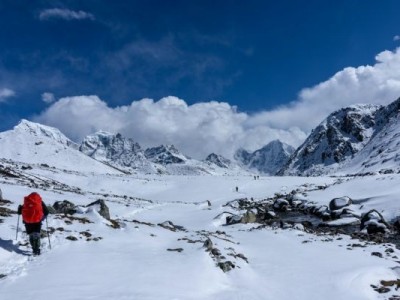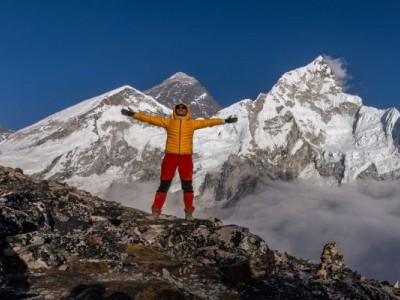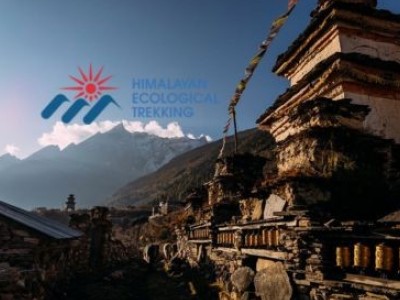Overview of Both Treks
Annapurna Circuit Trek
The Annapurna Circuit offers amazing diversity in landscape, cultures and ecosystems while encircling the Annapurna massif. It is also known as the "Apple Pie Circuit" because of the teahouse options for snacks along the route. Depending on which part of the journey has motorable roads, the hike can be anywhere from 160 to 230 km long.
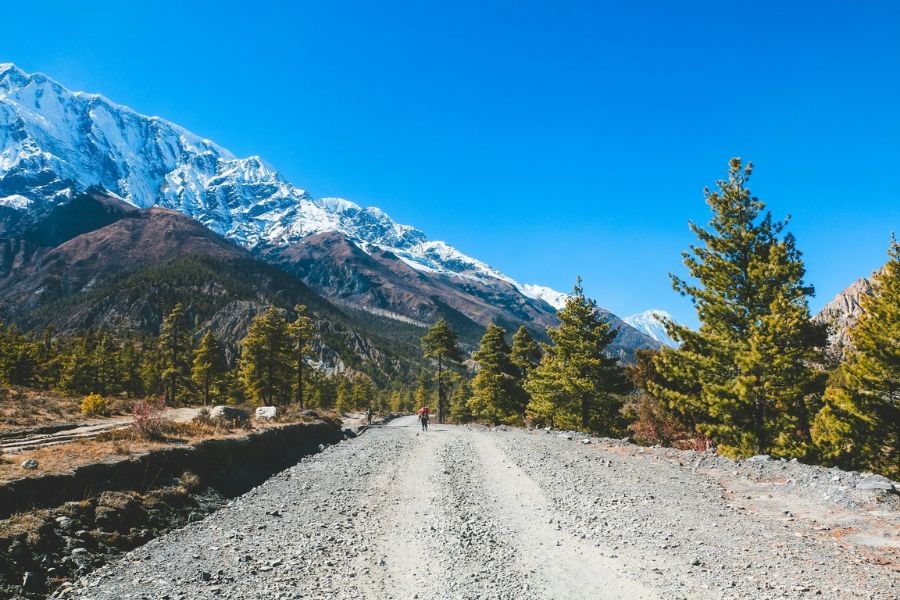
Views of the Annapurna range, Dhaulagiri, Machhapuchhre, Manaslu, Gangapurna, and Tilicho Peak are available along the journey, which traverses Thorong La Pass (5,416 m). The Annapurna circuit covers diverse climate zones; in the first few days, there are subtropical valleys with rice paddies and then through arid topography which resembles Tibetan plateaus.
Everest Base Camp Trek
The Everest Base Camp (EBC) trek, as the name suggests, takes hikers to the foot of the world's tallest mountain. Unlike the “circuit” style of the Annapurna trek, Everest Base Camp is an out-and-back trek, meaning you will return back along much of the same path.
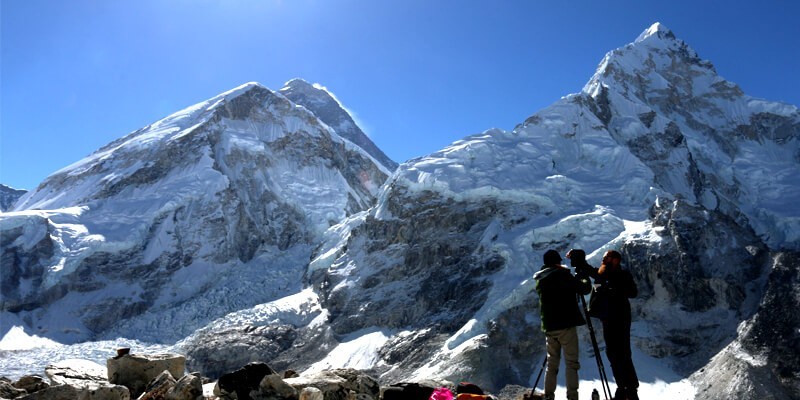
This trip starts with a mountain flight to Lukla airstrip (and slight issues with altitude) and goes through the famous Sherpa capital of Namche Bazaar, before heading through the Khumbu Valley and Sagarmatha National Park to EBC (5,364m) and the Kala Patthar viewpoint (5,545m) for views of the summit of Mount Everest.
Quick Comparison
| Feature | Annapurna Circuit | Everest Base Camp |
| Duration | 14-21 days (full circuit) | 12-14 days |
| Maximum Elevation | 5,416m (Thorong La Pass) | 5,545m (Kala Patthar) |
| Total Distance | 160-230 km (full circuit) | 130 km round trip |
| Starting Point | Besisahar/Bhulbhule | Lukla |
| Best Seasons | March-May, September-November | March-May, September-November |
| Trail Style | Circuit (loop) | Out-and-back |
Difficulty Level Comparison
Physical Demands
Both of these treks (the Annapurna Circuit and the EBC trek) are definitely difficult and should not be taken lightly. Each trek entails consecutive days of hiking, in the range of 5-7 hours hiking daily, or more, over difficult terrain.
The Annapurna Circuit covers more distance and has diverse terrain. One of the difficult aspects of the Annapurna Circuit is having to cross Thorong La Pass (5,416m). This represents the longest and hardest day of the entire trek because you will be hiking before dawn, then you have a long, steep ascent, and you have a long descent.
The EBC trek has less distance daily but has elevation gain daily, as there are many "Nepali flat" sections, which are constant up-downs in elevation, along with quite a few steeper inclines. Similar to the Annapurna Circuit, you will need a minimum of 12 to 14 days of hiking to complete the trek to Everest base camp to allow for an appropriate acclimatisation schedule.
Altitude Considerations
While both treks have similar maximum altitudes, the way they approach altitude is very different.
The Annapurna Circuit ascends less rapidly, so you have much better natural acclimatisation. You start around 800m and you are ascending for many days before crossing Thorong La Pass, and so it is fair to say the Annapurna circuit is a milder option in terms of altitude sickness than Everest Base Camp.
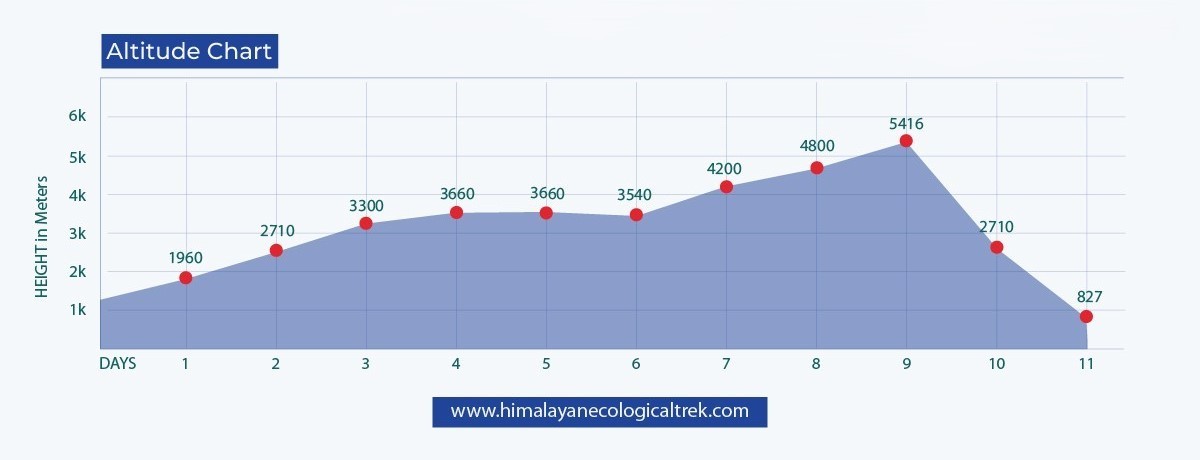
The Everest Base Camp trek starts at Lukla (2,860m), and in just two days, you will reach Namche Bazaar (3,440m). The quick elevation gain from Lukla to Namche means your body needs acclimatisation days. After Namche, the trek requires that you spend a number of days at high elevations, or at elevations where altitude sickness is a concern, without acclimatisation.
Which is a beginner-friendly trek, EBC or ACT?
For a first-time Himalayan trekker, both options are difficult but accomplishable with the proper preparation.
The Annapurna Circuit may be slightly more beginner-friendly, primarily due to its more gradual ascent with more natural acclimatisation. There are also more exit points along the Annapurna Circuit if you need to exit the trek early.
Everest Base Camp presents a more abrupt acclimatisation curve and fewer opportunities to exit once past Namche Bazaar. The consistently higher altitude and colder temperatures can be challenging for those who have trekked at less than high altitude.
Both treks do not require any technical climbing or mountaineering experience, and each year, thousands of beginners successfully complete both treks if they are well prepared.
Trail Experience & Landscapes
Terrain Diversity
The Annapurna Circuit has unmatched diversity in terms of terrain and ecosystems. You will trek through subtropical forests, terraced rice fields, dry high-altitude desertlands like Tibet, rhododendron forests, and alpine zones. This variety will mean you are seeing something new almost every day.
The Everest Base Camp trek has a bit less variety, but does offer an increasingly dramatic level of high mountain scenery. Outside of the initial segment of forested trails near Lukla, the trail evolves into high-altitude scenarios that include impressive alpine vistas, glaciers, and towering peaks.
Cultural Experiences
The cultural experiences you will find on either trek are pleasing and rewarding experiences in their own right, on a par with the sheer beauty of the scenery.
The Annapurna Circuit travels through areas inhabited by several ethnic groups, including Gurung, Manange (from Manang), and Thakali, each with their own cultural traditions, construction styles, and types of food. The western part of the circuit will be heavily influenced by Tibet with monks and monasteries, mani walls, and prayer flags everywhere.
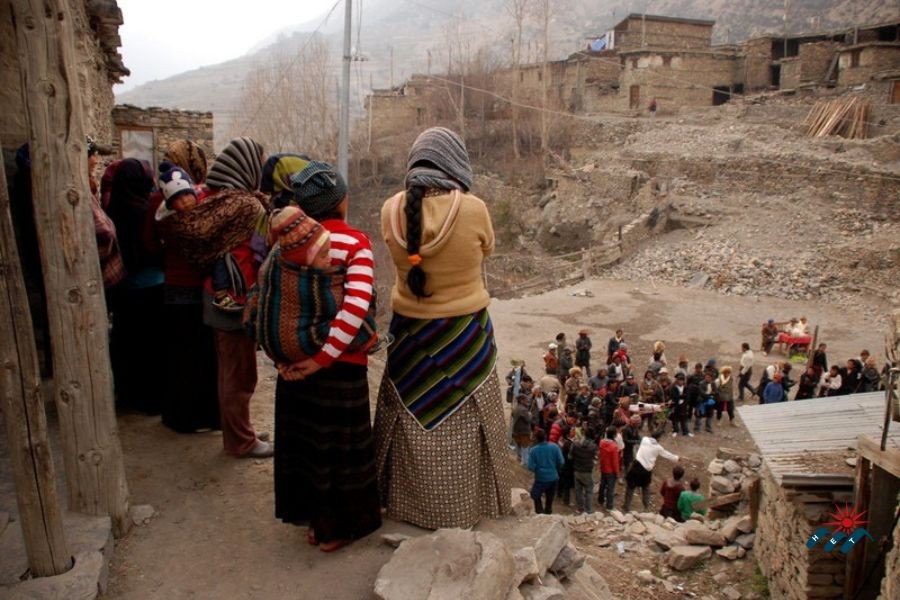
The Everest Base Camp trek will get you deep into the land of the Sherpas, generally known in the world for their mountaineering expertise as well as their Buddhist culture. Namche Bazaar, Tengboche Monastery, Sherpa villages and stupas, and prayer wheels on the trail are the highlights of this trek.
Trail Structure
The route to Everest Base Camp is an out-and-back trek, which means that you will be returning a good bit of the way via the exact path as you ascended. This has its advantages and disadvantages; you will witness the same landscapes from different angles, light, etc.; you won't experience constantly new and novel terrain. As a counterexample, the "traditional" Annapurna Circuit is a loop in which you will enjoy new views and experiences every day. Having said all this, road development has changed this a little bit, as many trekkers who now go on this trek fly back from Jomsom or take a jeep/taxi or bus back from Tatopani after basically ending their trek in Jomsom.
Logistics & Planning
Duration for the Hike
This hike for the Everest Base Camp trek needs 12 to 14 days, depending on the number of acclimatisation days built in, and the travel days to and from Kathmandu. This 12-14 day duration is relatively fixed as the hiker must require safe acclimatisation.
This hike is much more flexible for the Annapurna Circuit as the time spent is variable:
- Mini-circuit (Chame to Jomsom): 10-12 days
- Half-circuit (Besisahar to Jomsom): 14-16 days
- Full circuit with side trips: 18-22 days
Getting Around
The majority of Everest Base Camp Trekkers fly from Kathmandu to Lukla, a small alpine airfield. The beautiful mountain flight only takes about 30 minutes, but it is almost exclusively dependent on the weather, so there are many delays and even cancellations.
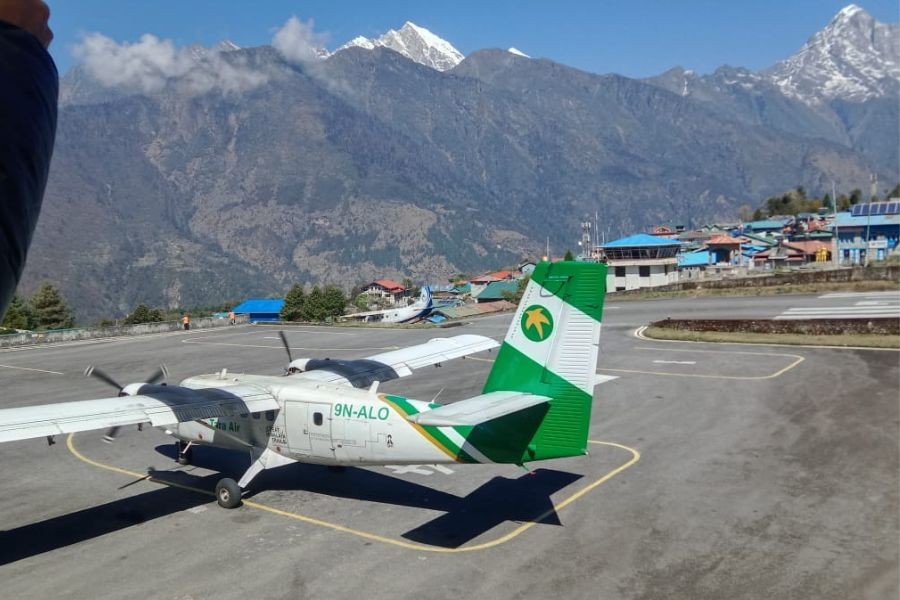
The Annapurna Circuit mostly begins in Besisahar after a 5 to 6-hour bus or private vehicle journey from Kathmandu. The road is generally in good condition and would be much more easily relied upon than the weather-dependent flight to Lukla.
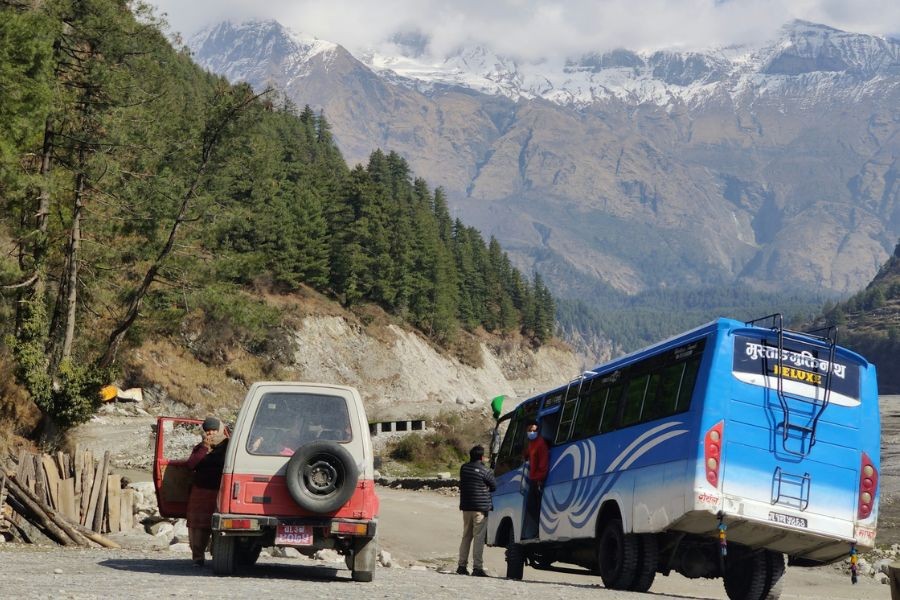
Permits and fees
Both treks require permits with nearly the same cost of about $40-50 total :
For the Annapurna Circuit:
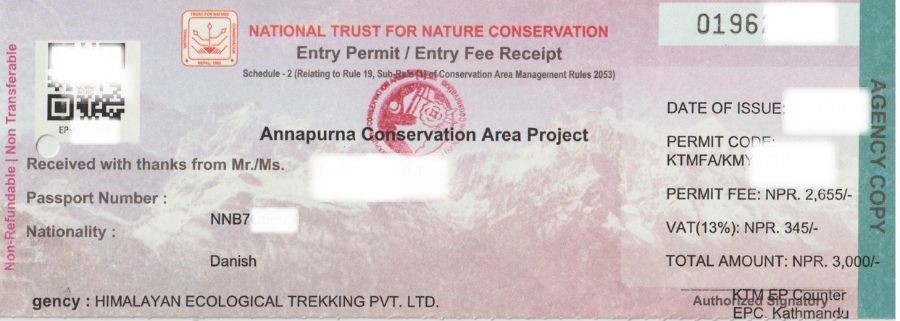
For the Everest Base Camp:
- Sagarmatha National Park Entry Permit: ~$25
- Khumbu Pasang Lhamu Rural Municipality Entrance Fee: ~$17
Cost Comparison: Everest Trek vs Annapurna Trek Cost
Transportation Costs
The transportation costs for the Everest Base Camp trek are considerably higher since you first have to fly to Lukla (which typically costs $360-440 round trip) before embarking on the trek itself.
Transportation costs are much lower for the Annapurna Circuit, as you can take a public bus to Besisahar for $5-10 each way or private transportation for $50-100 each way.
Accommodation and Food
The Everest region generally has higher rates:
- Teahouse accommodation: $5-30 per night (more expensive when you get to higher altitudes)
- Meals: $5-15 (even more expensive at higher elevations)
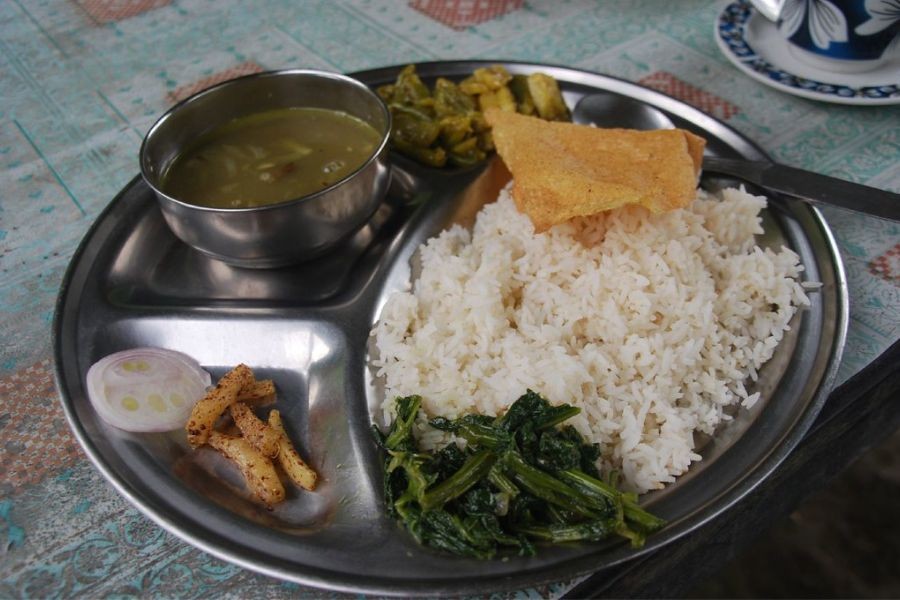
The Annapurna Circuit usually has lower rates:
- Teahouse accommodation: $3-10 per night
- Meals: $4-12
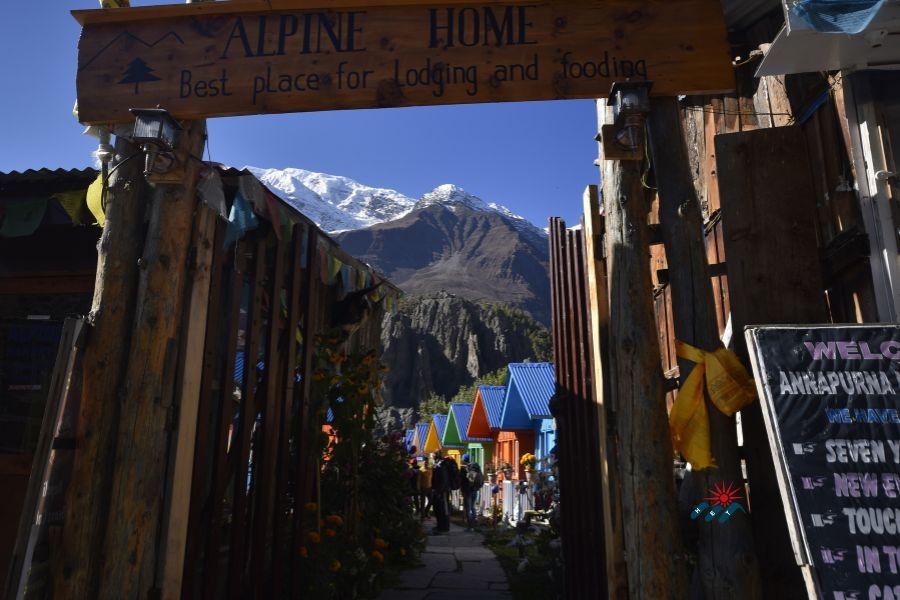
Total Budget Comparison
For a 12-day Everest Base Camp trek:
- Independent trekker: $1,200-1,800
- With a guide only: $1,550-2,300
- With a guide and porter: $1,850-2,700
For an 11-day Annapurna Circuit:
- Independent trekker: $800-1,200
- With a guide only: $1,200-1,700
- With a guide and porter: $1,500-2,100
The Annapurna Circuit Trek Cost is usually at least 20-30% less expensive than Everest Base Camp.
Best Seasons for Each Trek
Both treks share the same principal trekking seasons:
Autumn (September to November): The post-monsoon trekking season offers the best possibilities for clear skies and calm weather. October is the best month to trek, with the mountains crystal clear, pleasant daytime temperatures, and little precipitation.
Spring (March to May): The second-best season, with increasing temperatures, blossoming rhododendron forests, and general good visibility, although not as clear as autumn.
Winter (December-February) will be much colder for the Everest Base Camp trek, and the Thorong La Pass, which was crossed in low snowfall conditions in March of that year, was closed when faced with three feet of snow in late December.
During the monsoon season (June-August), while the Annapurna Circuit's western portion lies in a rain shadow and is drier than the eastern portion, the trek may still make a partial circuit a more worthwhile effort than the otherwise wet conditions endemic to the Everest region.
Read more about the Annapurna Circuit Trek Best Time.
Unique Highlights
Unusual Experiences: Annapurna Circuit
- Crossing Thorong La Pass: This 5,416m pass includes a challenging crossing and a pre-dawn start.
- Ecological Diversity: This offers a range of different ecosystems on one trip.
- Tilicho Lake: There is an optional diversion to one of the world's highest lakes.
- Muktinath Temple: A holy place for both Hindus and Buddhists.
- Tatopani Hot Springs: A natural way to soothe tired muscles.
- Upper Mustang Culture: Some exposure to a Tibetan-influenced culture.
Unusual Experiences Everest Base Camp
- Standing at the Foot of Everest: An impossible experience in the world's highest place.
- Kala Patthar Sunrise/Sunset: Classic panorama views of Everest, Nuptse and Lhotse.
- Namche Bazaar: A bustling Sherpa capital and a popular destination for mountaineers.
- Tengboche Monastery: An important spiritual centre and backdrop to Everest.
- Mountaineering History: A culture rich in climbing history, achievement and culture.
Making Your Decision: Which trek is Best to go ACT or the EBC?
Think About Your Preferences
Pick the Annapurna Circuit if you prefer:
- Cultural and ecological diversity
- A longer, highly immersive trek
- A trek with generally lower foot traffic
- A long trek with gradual acclimatisation, and therefore lower risk of altitude sickness
- A trek with more varied daily experiences and landscapes
- A trek with lower total costs
- A loop trek with less back-tracking
Pick Everest Base Camp if you prefer:
- An adventure of a lifetime at the foot of the tallest peak in the world
- Sherpa culture and mountaineering history
- Stunning, dramatic high mountain scenery throughout
- A slightly shorter trek
- More predictable, high-quality, prefabricated lodge-style accommodations at major rest stops
- Enjoyment of a trek with prestige walking associated with the name of Everest
Time Situation
- 10–12 days: either the regular EBC or the abbreviated Annapurna Circuit
- 14-16 days: Either trek is fine
- 18 days or longer: The full Annapurna Circuit including side trips or EBC with extensions
Subjectivity
Sometimes it is as simple as which mountains "speak" to you personally:
- Are you excited about the prospect of seeing the tallest mountain in the world up close?
- Do you prefer the diversity and cultural experience of the Annapurna region?
- Which experience inspires your retrospective photographs and stories?
Eco-Friendly Trekking Tips
Himalayan Ecological Trekking believes in helping to sustain Nepal's delicate mountain environments. Regardless of what trek you pick, keep these sustainable practices in mind:
- Waste Management: Use reusable water containers; pack out rubbish that cannot be biologically decomposed.
- Support Local Communities: Stay at locally owned teahouses; purchase local art and crafts.
- Energy Conservation: Limit showers to a few minutes; limit charging when devices
- Responsible Wildlife Viewing: Keep your distance from wildlife; stay on established trails.
Conclusion
Both the Annapurna Circuit and the Everest Base Camp treks provide life-changing Himalayan experiences, and neither trek is "better" or "worse" than the other for your trek. Each trek has unique advantages and challenges.
The Annapurna Circuit provides unmatched variation, a more gradual acclimatisation process, and a fuller cultural experience traversing several ethnic regions. It is generally cheaper and more adaptable in length.
The trek to Everest Base Camp, on the other hand, provides the matchless experience of standing at the foot of the highest mountain in the world; immerses you more deeply into Sherpa culture; and offers consistently stunning scenery and a generally higher standard of facilities.
Both treks are difficult, however, both treks will be challenging, but they are achievable for trekkers who are reasonably fit and prepared. The right trek is dependent upon your desires, time, and expectations for your epic Himalayan experience.
No matter which trek you take, Himalayan Ecological Trekking will make your dream trek come true with our professional guides, sustainability practices, and dedication to authentic Himalayan experiences.
FAQs
Which Trek is Best to Go – ACT or EBC?
The type of experience you're looking for will determine the perfect trek. The Annapurna Circuit (ACT) is ideal for those who want a diverse trek with constantly changing landscapes, from lush subtropical forests to arid high-altitude deserts. It offers a more immersive cultural experience with Hindu villages and Tibetan settlements along the way, and is generally more budget-friendly since it doesn't require expensive flights. The loop trail means you're always seeing new scenery without backtracking.
The Everest Base Camp (EBC) trek, on the other hand, is the ultimate choice for those who dream of seeing Mount Everest up close. It immerses you in Sherpa culture, takes you through legendary locations like Namche Bazaar and Tengboche Monastery, and gives you that classic mountaineering feeling of following in the footsteps of famous climbers. While more challenging due to the altitude, it's a bucket-list adventure that delivers unparalleled mountain views.
Which Trek is Beginner-Friendly – EBC or ACT?
The Annapurna Circuit is generally more beginner-friendly for several important reasons. First, the altitude gain is more gradual, which gives your body more time to acclimate properly. While Thorong La Pass reaches 5,416m, you ascend to this height over about 12 days compared to EBC's quicker push to similar elevations. The ACT also has more teahouse options along the way, making it easier to take rest days if needed. The temperatures tend to be milder at lower elevations, too.
That said, Everest Base Camp isn't impossible for beginners - many first-time trekkers complete it successfully. However, it does present greater challenges. The rapid altitude gain increases the risk of acute mountain sickness, the conditions are colder and windier, and the trail involves more relentless steep sections. Fit beginners can certainly do EBC, but they need to be extra cautious about acclimatisation.
Why Choose the Everest Base Camp Trek?
The Everest Base Camp hike is the best option for five strong reasons. First and foremost is the chance to stand at the base of the world's highest mountain - an experience that stays with you forever. Secondly, the trek immerses you in authentic Sherpa culture, from the colourful prayer wheels to the ancient monasteries. The mountain views are simply unmatched, with iconic peaks like Ama Dablam and Lhotse surrounding you. There's also the incredible sense of walking in the footsteps of mountaineering legends like Edmund Hillary. Finally, completing EBC is one of those rare, truly bucket-list-worthy achievements that gives you bragging rights for life.
Why Choose the Annapurna Circuit Trek?
The Annapurna Circuit offers five distinct advantages that make it special. It's arguably the most diverse trek in Nepal, taking you through an incredible variety of landscapes from tropical jungles to high-altitude deserts. The cultural experience is richer and more varied, with Hindu villages, Tibetan Buddhist monasteries, and Gurung communities along the route. Crossing Thorong La Pass provides a satisfying high-altitude challenge without being as extreme as EBC. Financially, it's more accessible since you don't need expensive flights to Lukla. Perhaps most appealing to some trekkers, the trails are noticeably less crowded than the Everest region, offering a more peaceful experience.
Is Annapurna Circuit Easier Than Everest Base Camp?
Yes, the Annapurna Circuit is generally considered easier than Everest Base Camp, but with some important qualifications. The ACT's main advantage is its more gradual altitude gain, which gives your body more time to adjust and significantly reduces the risk of altitude sickness. The temperatures tend to be warmer at lower elevations, and the climbs are generally less steep than EBC's relentless ascents and descents.
However, "easier" doesn't mean easy. Thorong La Pass at 5,416m is still a serious challenge that requires good fitness and proper acclimatization. The trek is also longer, typically 12-18 days, compared to EBC's 12-14. Everest Base Camp is tougher primarily because of the faster altitude gain, harsher weather conditions, and more physically demanding trail sections. Both require solid fitness, but ACT is the more manageable option for most people.
Is Everest Base Camp Better Than Annapurna Circuit?
Neither trek is objectively better - they simply offer different experiences that appeal to different types of trekkers. Everest Base Camp is the clear choice if your dream is to see Mount Everest up close and experience that classic Himalayan mountaineering atmosphere. The mountain scenery is more concentrated and dramatic, and there's an undeniable prestige that comes with completing this legendary trek.
The Annapurna Circuit, meanwhile, provides a more complete and varied experience of Nepal. You'll see a much wider range of landscapes and cultures, enjoy quieter trails, and have a more relaxed acclimatisation schedule. It's also significantly more budget-friendly. For many trekkers, this diversity makes ACT a more rewarding overall experience.
Ultimately, EBC is better for those specifically seeking the Everest experience, while ACT is better for those wanting a broader Himalayan adventure. Many seasoned trekkers end up doing both at different times, as they're complementary rather than competing experiences.
Prepared to Explore the Himalayan Region?
Himalayan Ecological Trekking is the premier provider of sustainable trekking adventures in Nepal's breathtaking scenery. Whether you choose the world's most famous Everest Base Camp Trek, or the incredibly diverse Annapurna Circuit (and everything in between), we promise that your trek will be safe, sustainable, and unforgettable.
What We Offer:
- A Private Online Briefing – to provide detailed pre-trek advice from our experts
- Eco-Conscious – We practice eco-friendly behaviours on each of our trails
- Local Sherpa & Gurung Guides – have access to local knowledge and insight only available from our mountain professionals
- Flexible Itineraries That Match Individual – everyone has different fitness levels, interests, and wants
Get Started:
- Chat with one of our Trek Consultants,
- Email us for a custom itinerary, or
- Join us at the next free online briefing
"The mountains are calling, answer them!" – Himalayan Ecological Trekking Team
Inquire Now: [email protected], Online Briefing: WhatsApp: +977 9851006023 (Bikesh)









